113 Painting Rack 2
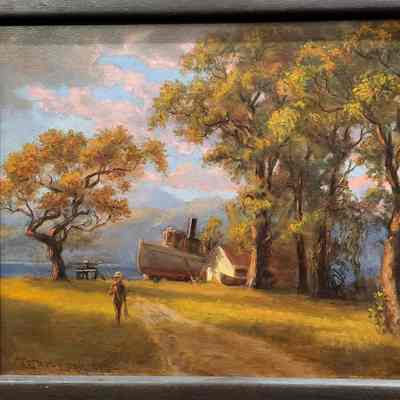

Basin Harbor
Name/Title
Basin Harbor
Type of Painting
Description
Landscape image of dirt lane, trees, water and a mountain backdrop. A child is depicted in the foreground with a fishing pole and brace of fish. A small, white building with brown roof is in the middle ground. A small dory or other such watercraft is in front of the building. A large steam-powered vessel sits on blocks, partially obscured by the building. The boat has a fairly large hull with red and white paint. A small pilot house sits forward of a steam engine and black funnel. A wooden, hand-operated winch or windlass is located on the ground near the bow of the steamboat. The painting is signed in the lower left by artist Custer Ingham. Painted on board, the back of the work has the artist's name in pencil as well as the date 1916.
Acquisition
Accession
2023.7
Artwork Details
Medium
Oil
Made/Created
Artist Information
Ingham, Harvey Custer (1863-1931)
Artist
Date made
1916
Dimensions
Width
29-1/2 in
Height
23-5/8 in
Entry/Object ID
2023.7.1
Context
Born during the Civil War and named for General George Armstrong Custer, Ingham began in the 1880s to paint scenes of daily life in the Champlain Valley, including Lake Champlain’s Westport Sail Ferry, a baseball game on the banks of Otter Creek, and the family farm. The falls and the basin below on Otter Creek were favorite topics.
Early in his career, Ingham studied at the National Academy of Design in New York for two years; later, a brief visit to Europe in 1914 was cut short by the outbreak of World War I. Although he chose a realist approach, many of Ingham’s works demonstrate his interest in experimenting with the artistic movements of his era, evoking the trompe l’oeil paintings of William Harnett, landscapes of the Barbizon and Hudson River schools, and the colors and atmospheric effects of the Impressionists.
Early in his career, Ingham studied at the National Academy of Design in New York for two years; later, a brief visit to Europe in 1914 was cut short by the outbreak of World War I. Although he chose a realist approach, many of Ingham’s works demonstrate his interest in experimenting with the artistic movements of his era, evoking the trompe l’oeil paintings of William Harnett, landscapes of the Barbizon and Hudson River schools, and the colors and atmospheric effects of the Impressionists.
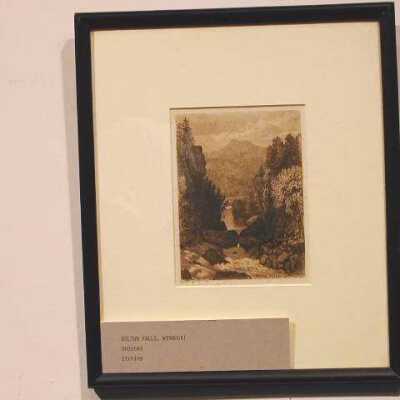

Bolton Falls, Winooski
Name/Title
Bolton Falls, Winooski
Description
Landscape. View from top of Falls, rocket stream bed, water rushing from lower left to frothy area center foreground. Calm stream/river center middle ground. Trees and rocks left and right edge. Camel's Hump in background.
Acquisition
Source (if not Accessioned)
Unknown
Relationships
Related Publications
James Franklin Gilman
Publication
Artwork Details
Medium
Paper, Ink
Subject
Camel's Hump and Bolton Falls
Made/Created
Artist Information
Gilman, James Franklin (1850-1929)
Artist
Date made
1889-1891
Dimensions
Width
4-1/2 in
Height
6 in
Entry/Object ID
VHS-A-259
Context
James Franklin Gilman was born in 1850 in Woburn, Massachusetts to John and Elizabeth Gilman. His father was a cordwainer and his mother a seamstress. Early census records indicate his mother was born in Vermont. Little is known of his early life or education.
By the late 1860s he evidently made his living as an itinerant artist, often depicting the farm landscape and/or portraits of those providing him with room and board. Works remain of farms and people in Chelmsford, Groton, and Billerica, MA.
In 1872 he arrived in Barre, Vermont, a tall man with red hair and a distinctive red beard. He spent over twenty years in the general vicinity of Barre, Montpelier, Plainfield, and Calais. Most of the time was spent boarding with various farm families, though he did open a studio and school in Montpelier for a time.
At some point in the late 1880s he joined the Church of Christian Scientists and became acquainted with church founder Mary Baker Eddy. From 1889 to 1891 he boarded at the Perrin farm in Berlin. He supposedly fell in love with Mary Perrin, a daughter in the household. Her father decline to let the couple married due to Gilman's occupation as an itinerant painter and his newfound religion. His diary indicates this composition was made during a trip he and Mary took to Bolton.
He ultimately sold all of his works and the contents of his studio, some say in reaction to this lost love, and moved back to Massachusetts in 1891. He famously illustrated a poem entitled "Christ and Christmas" by Eddy.
The last decade of his life was spent in Athol, MA were he lived on the edge of poverty, passing away in 1929. Mary Perrin remained on the family farm, never married and died at the age of 72 in 1932.
By the late 1860s he evidently made his living as an itinerant artist, often depicting the farm landscape and/or portraits of those providing him with room and board. Works remain of farms and people in Chelmsford, Groton, and Billerica, MA.
In 1872 he arrived in Barre, Vermont, a tall man with red hair and a distinctive red beard. He spent over twenty years in the general vicinity of Barre, Montpelier, Plainfield, and Calais. Most of the time was spent boarding with various farm families, though he did open a studio and school in Montpelier for a time.
At some point in the late 1880s he joined the Church of Christian Scientists and became acquainted with church founder Mary Baker Eddy. From 1889 to 1891 he boarded at the Perrin farm in Berlin. He supposedly fell in love with Mary Perrin, a daughter in the household. Her father decline to let the couple married due to Gilman's occupation as an itinerant painter and his newfound religion. His diary indicates this composition was made during a trip he and Mary took to Bolton.
He ultimately sold all of his works and the contents of his studio, some say in reaction to this lost love, and moved back to Massachusetts in 1891. He famously illustrated a poem entitled "Christ and Christmas" by Eddy.
The last decade of his life was spent in Athol, MA were he lived on the edge of poverty, passing away in 1929. Mary Perrin remained on the family farm, never married and died at the age of 72 in 1932.
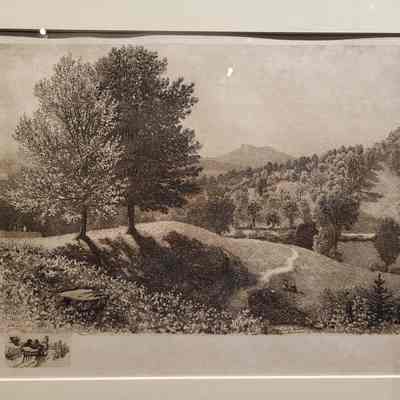

Camel's Hump From A Point Of View In Berlin, VT.
Name/Title
Camel's Hump From A Point Of View In Berlin, VT.
Description
Landscape. 2 trees upper left center, view from rise into valley. lower left, rock surrounded by vegetation, path leading from lower right into middleground. 2 children at right. Forested hillside to Camel's Hump in background. Small scene lower left. Man and woman in sleigh being pulled by white horse.
Acquisition
Source (if not Accessioned)
Unknown
Relationships
Related Publications
James Franklin Gilman
Publication
Artwork Details
Medium
Paper, Ink
Subject
Camel's Hump
Made/Created
Artist Information
Gilman, James Franklin (1850-1929)
Artist
Date made
1889
Dimensions
Width
24 in
Height
19 in
Entry/Object ID
VHS-A-262
Context
James Franklin Gilman was born in 1850 in Woburn, Massachusetts to John and Elizabeth Gilman. His father was a cordwainer and his mother a seamstress. Early census records indicate his mother was born in Vermont. Little is known of his early life or education.
By the late 1860s he evidently made his living as an itinerant artist, often depicting the farm landscape and/or portraits of those providing him with room and board. Works remain of farms and people in Chelmsford, Groton, and Billerica, MA.
In 1872 he arrived in Barre, Vermont, a tall man with red hair and a distinctive red beard. He spent over twenty years in the general vicinity of Barre, Montpelier, Plainfield, and Calais. Most of the time was spent boarding with various farm families, though he did open a studio and school in Montpelier for a time.
At some point in the late 1880s he joined the Church of Christian Scientists and became acquainted with church founder Mary Baker Eddy. From 1889 to 1891 he boarded at the Perrin farm in Berlin, the location of this image. He supposedly fell in love with Mary Perrin, a daughter in the household. The small vignette in the lower left depicts James and Mary in a sleigh. A short love poem is in the composition above. Her father declined to let the couple marry due to Gilman's occupation as an itinerant painter and his newfound religion.
He ultimately sold all of his works and the contents of his studio, some say in reaction to this lost love, and moved back to Massachusetts in 1891. He famously illustrated a poem entitled "Christ and Christmas" by Eddy.
The last decade of his life was spent in Athol, MA were he lived on the edge of poverty, passing away in 1929. Mary Perrin remained on the family farm, never married and died at the age of 72 in 1932.
By the late 1860s he evidently made his living as an itinerant artist, often depicting the farm landscape and/or portraits of those providing him with room and board. Works remain of farms and people in Chelmsford, Groton, and Billerica, MA.
In 1872 he arrived in Barre, Vermont, a tall man with red hair and a distinctive red beard. He spent over twenty years in the general vicinity of Barre, Montpelier, Plainfield, and Calais. Most of the time was spent boarding with various farm families, though he did open a studio and school in Montpelier for a time.
At some point in the late 1880s he joined the Church of Christian Scientists and became acquainted with church founder Mary Baker Eddy. From 1889 to 1891 he boarded at the Perrin farm in Berlin, the location of this image. He supposedly fell in love with Mary Perrin, a daughter in the household. The small vignette in the lower left depicts James and Mary in a sleigh. A short love poem is in the composition above. Her father declined to let the couple marry due to Gilman's occupation as an itinerant painter and his newfound religion.
He ultimately sold all of his works and the contents of his studio, some say in reaction to this lost love, and moved back to Massachusetts in 1891. He famously illustrated a poem entitled "Christ and Christmas" by Eddy.
The last decade of his life was spent in Athol, MA were he lived on the edge of poverty, passing away in 1929. Mary Perrin remained on the family farm, never married and died at the age of 72 in 1932.
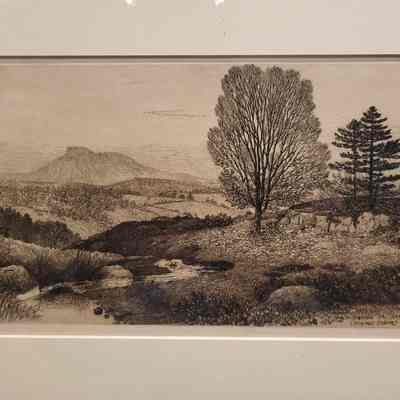

Camel's Hump from the Pasture in November
Name/Title
Camel's Hump from the Pasture in November
Description
Landscape. Stream lower left, dropping off (out of sight) into valley. Large trees upper center to right, rocks lower right center, meadows and forested area and Camel's Hump in background, bird formation upper center
Acquisition
Source (if not Accessioned)
Unknown
Relationships
Related Publications
James Franklin Gilman
Publication
Artwork Details
Medium
Paper, Ink
Subject
Camel's Hump
Made/Created
Artist Information
Gilman, James Franklin (1850-1929)
Artist
Date made
1890
Dimensions
Width
12 in
Height
6-1/2 in
Entry/Object ID
VHS-A-261
Context
James Franklin Gilman was born in 1850 in Woburn, Massachusetts to John and Elizabeth Gilman. His father was a cordwainer and his mother a seamstress. Early census records indicate his mother was born in Vermont. Little is known of his early life or education.
By the late 1860s he evidently made his living as an itinerant artist, often depicting the farm landscape and/or portraits of those providing him with room and board. Works remain of farms and people in Chelmsford, Groton, and Billerica, MA.
In 1872 he arrived in Barre, Vermont, a tall man with red hair and a distinctive red beard. He spent over twenty years in the general vicinity of Barre, Montpelier, Plainfield, and Calais. Most of the time was spent boarding with various farm families, though he did open a studio and school in Montpelier for a time.
At some point in the late 1880s he joined the Church of Christian Scientists and became acquainted with church founder Mary Baker Eddy. From 1889 to 1891 he boarded at the Perrin farm in Berlin, the location of this image. He supposedly fell in love with Mary Perrin, a daughter in the household. Her father declined to let the couple marry due to Gilman's occupation as an itinerant painter and his newfound religion.
He ultimately sold all of his works and the contents of his studio, some say in reaction to this lost love, and moved back to Massachusetts in 1891. He famously illustrated a poem entitled "Christ and Christmas" by Eddy.
The last decade of his life was spent in Athol, MA were he lived on the edge of poverty, passing away in 1929. Mary Perrin remained on the family farm, never married and died at the age of 72 in 1932.
By the late 1860s he evidently made his living as an itinerant artist, often depicting the farm landscape and/or portraits of those providing him with room and board. Works remain of farms and people in Chelmsford, Groton, and Billerica, MA.
In 1872 he arrived in Barre, Vermont, a tall man with red hair and a distinctive red beard. He spent over twenty years in the general vicinity of Barre, Montpelier, Plainfield, and Calais. Most of the time was spent boarding with various farm families, though he did open a studio and school in Montpelier for a time.
At some point in the late 1880s he joined the Church of Christian Scientists and became acquainted with church founder Mary Baker Eddy. From 1889 to 1891 he boarded at the Perrin farm in Berlin, the location of this image. He supposedly fell in love with Mary Perrin, a daughter in the household. Her father declined to let the couple marry due to Gilman's occupation as an itinerant painter and his newfound religion.
He ultimately sold all of his works and the contents of his studio, some say in reaction to this lost love, and moved back to Massachusetts in 1891. He famously illustrated a poem entitled "Christ and Christmas" by Eddy.
The last decade of his life was spent in Athol, MA were he lived on the edge of poverty, passing away in 1929. Mary Perrin remained on the family farm, never married and died at the age of 72 in 1932.
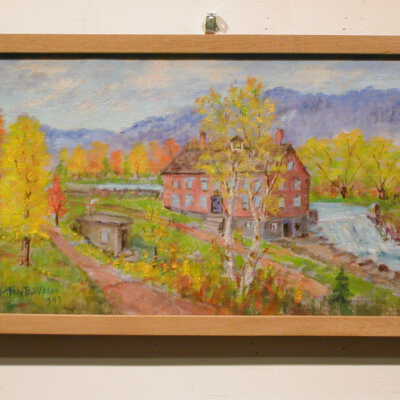

Gay Brothers Mill
Name/Title
Gay Brothers Mill
Description
Landscape. Fall foliage, mill in center next to river with waterfall, road next to mill, small building next to road. Mountains in background. Trees next to river and by road.
Acquisition
Source (if not Accessioned)
Unknown
Relationships
Related Publications
Neither Wealth nor Poverty
Publication
Artwork Details
Medium
Oil
Subject
Gay Brothers' Mill
Made/Created
Artist Information
Wilder, Arthur Brickett, Sr. (1857-1949)
Artist
Date made
1943
Dimensions
Width
18-1/4 in
Height
10 in
Entry/Object ID
VHS-A-54
Context
Arthur Wilder, an fairly well-know landscape artist and former manager of the Woodstock Inn, created this work as the frontispiece of a VHS publication on the Gay Brothers' woolen Mills.
Though much of Wilder's work reflected the existing landscape he observed on painting trips, this particular piece depicts the original Tunbridge Mill as it would have appeared in the 1870s.
Founded in Tunbridge in 1869, the Gay Brothers company quickly expanded to larger Mills first in Cavendish and then in Ludlow. Going out of business in 1944, the publication and painting helped document the impressive run of a Vermont wool enterprise.
Though much of Wilder's work reflected the existing landscape he observed on painting trips, this particular piece depicts the original Tunbridge Mill as it would have appeared in the 1870s.
Founded in Tunbridge in 1869, the Gay Brothers company quickly expanded to larger Mills first in Cavendish and then in Ludlow. Going out of business in 1944, the publication and painting helped document the impressive run of a Vermont wool enterprise.
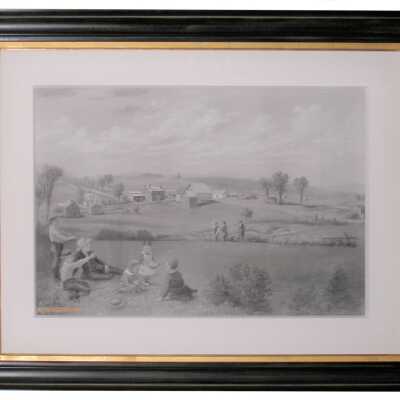

Kent Family at Kent's Corner
Interpretative Labels
Label
Kent Family at Kent's Corner, 1882
James Franklin Gilman (1842-1929)
Calais, VT
Charcoal on paper
Gift of J. Brooks Buxton, #A-788
This drawing depicts the area of Calais known as Kent's Corners due to the large number of Kent families that lived there. The building known as Kent Tavern once belonged to Vermont Historical Society and is now a Vermont State Historic Site. The people pictured are all descendants of patriarch Abdiel Kent.
James Gilman was a prolific landscape painter throughout Washington County in the late-19th century.
Name/Title
Kent Family at Kent's Corner
Description
Charcoal landscape drawing showing a family of six lounging on the bank of a river. Three additional people walk along the opposite bank, and a small town centered along a road can be seen beyond them. The buildings consist primarily of white structures with the notable exception of a stately brick house at the center. The landscape consists or rolling hills, partitioned with fences and sparsely dotted with trees.
Acquisition
Accession
2007.13
Relationships
Related Person or Organization
Kent, Dorman B.E. (1875-1951)
Person or Organization
Related Places
Place
Calais
Town
Washington County
County
Vermont
State/Province
United States of America
Country
North America
Artwork Details
Medium
Charcoal
Subject
Kent family
Made/Created
Artist Information
Gilman, James Franklin (1850-1929)
Artist
Painter
Role
Date made
1882
Dimensions
Width
38 in
Height
28 in
Entry/Object ID
2007.13.1
Context
This drawing depicts the area of Calais known as Kent's Corners due to the large number of Kent families that lived there. The building known as Kent Tavern once belonged to Vermont Historical Society and is now a Vermont State Historic Site. The people pictured are all descendants of patriarch Abdiel Kent.
James Gilman was a prolific landscape painter throughout Washington County in the late-19th century.
James Gilman was a prolific landscape painter throughout Washington County in the late-19th century.
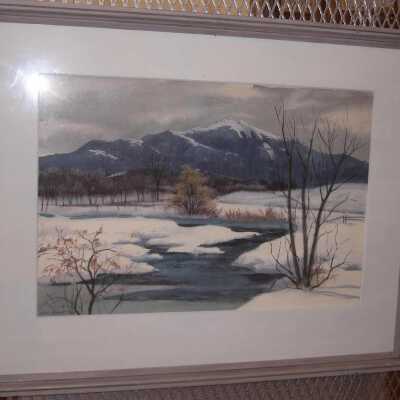

Landscape
Name/Title
Landscape
Type of Painting
Description
Watercolor - winter landscape with a stream meandering through a snow covered field. Snowy mountains in the background.
Acquisition
Accession
2009.28
Artwork Details
Medium
Watercolor
Made/Created
Artist Information
Barrett, Robert
Artist
Date made
1964-1984
Dimensions
Width
38-1/2 in
Height
30-5/8 in
Entry/Object ID
2009.28.1
Context
Signed Robert Barrett, AWS (American Watercolor Society). Little is known of this artist. A similar work sold at auction and had the location of Morrisville, Vermont written below his signature.
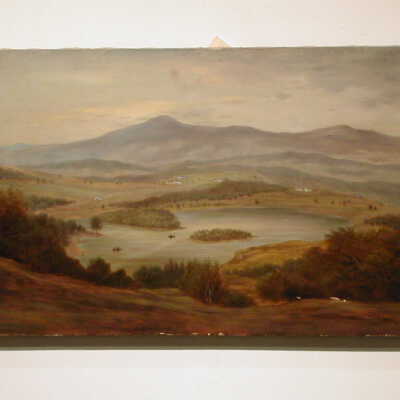

Lowell Lake
Name/Title
Lowell Lake
Description
Landscape--small lake, large peninsula, and small island viewed from hill in foreground. Trees surround lake in front at base of hill, meadow behind lake dotted with 5 farms, mountains in background, 2 boats on lake.
Acquisition
Source (if not Accessioned)
Underwood, Wynn
Artwork Details
Medium
Oil
Made/Created
Date made
1880-1900
Dimensions
Width
24 in
Height
16 in
Depth
1 in
Entry/Object ID
VHS-A-43
Context
This late 19th-century view, looking south from what is now Little Pond Road, of Lowell Lake in Londonderry, Vermont depicts the relatively treeless landscape of Vermont at the time. This area today is almost completely forested with large tracts of land conserved as a state park or part of the Green Mountain National Forest. The island, prominent in the center of the work, is known as Annie's Island.
Lowell Lake, orginally known as Derry Pond, was formed by the town of Londonderry as a reservoir. The dam at the south end of the lake has been replaced a number of times over the past century.
The south shore of lake, hosted a summer resort in the late 19th and early 20th century. Boaters on the lake may be visitors to this resort. In 1940, the resort was converted into a summer camp, which served, first just children, and then later families and operated until 1979. The old resort and camp infrastructure is now part of Lowell Lake State Park.
Lowell Lake, orginally known as Derry Pond, was formed by the town of Londonderry as a reservoir. The dam at the south end of the lake has been replaced a number of times over the past century.
The south shore of lake, hosted a summer resort in the late 19th and early 20th century. Boaters on the lake may be visitors to this resort. In 1940, the resort was converted into a summer camp, which served, first just children, and then later families and operated until 1979. The old resort and camp infrastructure is now part of Lowell Lake State Park.
Web Links and URLs
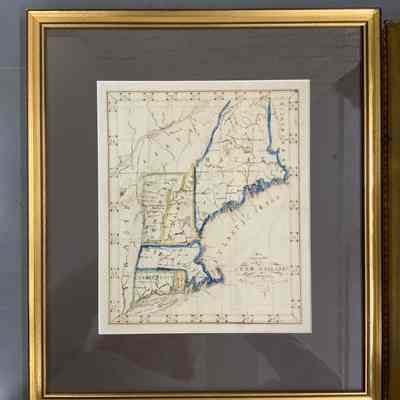

Map
Name/Title
Map
Description
Framed hand-drawn and colored map of New England by S.E. Henry of Chester, Vermont. The pen and ink map shows all six New England states bordered by the Atlantic Ocean, Canada, and New York, and features a decorative ink border denoting degrees of longitude and latitude. The coastline includes coastline depth indicators and the interior of each state includes many of the major rivers and cities or towns. Massachusetts and Maine are outlined in blue, New Hampshire and Rhode Island in yellow, and Connecticut and Vermont in green. There is a decorative cartouche in the lower right space of the ocean that reads, "Map of the Six NEW ENGLAND States Executed by S.E. Henry Chester VT 1867." The map is in a simple gold and black edged frame with a dark brown/gray mat.
Acquisition
Accession
2024.6
Relationships
Related Person or Organization
Henry, Sarah Elizabeth (1854-1882)
Person or Organization
Related Places
Place
Chester
Town
Windsor County
County
Vermont
State/Province
United States of America
Country
North America
Artwork Details
Medium
Ink, Watercolor
Made/Created
Artist Information
Henry, Sarah Elizabeth (1854-1882)
Artist
Painter
Role
Date made
1867
Dimensions
N/A
Entry/Object ID
2024.6.10
Context
Most likely drawn by Sarah Elizabeth Henry, age 12 or 13 of Chester, Vermont in 1867. Colloquilay referred to as "School Girl Maps," these copies of example maps were a common school project meant to teach geography. Though certainly produced by both boys and girls, those made by girls seem much more prevalent in museum collections.
Sarah Elizabeth Henry was born July 12, 1854 in Chester, Vermont to Hugh Horatio Henry (1814-1869) and his wife Sarah Henry (1812-1867). Sarah Elizabeth was the youngest of 11 children and lost her parents at a young age. Upon the death of her father in 1869 she joined her older sister's household. She died on July 10, 1882 at her sister's home of consumption (tuberculosis).
Sarah Elizabeth Henry was born July 12, 1854 in Chester, Vermont to Hugh Horatio Henry (1814-1869) and his wife Sarah Henry (1812-1867). Sarah Elizabeth was the youngest of 11 children and lost her parents at a young age. Upon the death of her father in 1869 she joined her older sister's household. She died on July 10, 1882 at her sister's home of consumption (tuberculosis).
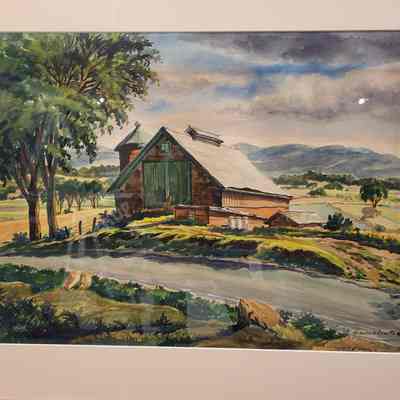

Painting
Name/Title
Painting
Description
Framed watercolor of a red barn with green doors. The bank barn is built into a hillside and faces a dirt road in the foreground. Fields and mountains can be seen in the background along with a stormy sky. Two large trees stand to the left of the barn. The scene probably depicts Addison County, Vermont.
Acquisition
Accession
2019.16
Artwork Details
Medium
Watercolor
Made/Created
Artist Information
Comito, Nicholas Umberto (1906-1990)
Artist
Date made
1945
Dimensions
Width
28-1/2 in
Height
23-1/2 in
Entry/Object ID
2019.16.1
Context
Nicholas Comito was born in Brooklyn, New York in 1906 to Italian immigrant parents. From an early age he showed an aptitude for art and ultimately studied that subject at the National Academy of Design school in Florence, Italy as well as in France and Switzerland. Like many artists he followed friends to Vermont for painting trips, spending extended time in Hartland, Windsor, and Middlebury.
He served in Texas during WWII and painted many works dealing with aviation and was commissioned to produce panels depicting the history of aviation medicine for the Research Building of the School of Aviation at Randolph Field. His work was also displayed at West Point, the Naval Academy, and the Coast Guard Academy.
According to various newspaper articles, he and his wife spent a fair amount of time in Vermont painting and participating in solo and group shows. A 1947 article from the Addison County Independent features a solo show at the Community House in Middlebury. His work, mainly of Addison County landscapes, is described as, "Romantic Realist."
He served in Texas during WWII and painted many works dealing with aviation and was commissioned to produce panels depicting the history of aviation medicine for the Research Building of the School of Aviation at Randolph Field. His work was also displayed at West Point, the Naval Academy, and the Coast Guard Academy.
According to various newspaper articles, he and his wife spent a fair amount of time in Vermont painting and participating in solo and group shows. A 1947 article from the Addison County Independent features a solo show at the Community House in Middlebury. His work, mainly of Addison County landscapes, is described as, "Romantic Realist."
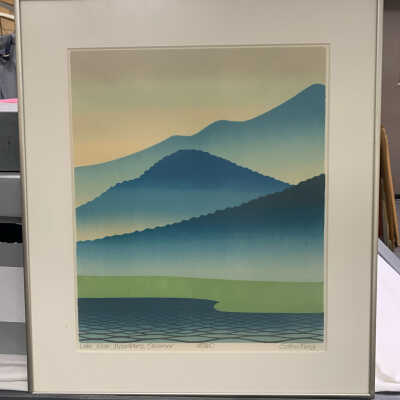

Print
Name/Title
Print
Description
Print on paper. Stacked perspective landscape with blue-lined lake in foreground, a green shore/beach, dark-blue hills in the middle-ground, light-blue mountain in the background with a beige sky. Print entitled, "Lake Near Mountains, Summer."
Acquisition
Accession
2021.42
Artwork Details
Medium
Paper, Ink
Made/Created
Artist Information
Field, Sabra Johnson (b. 1935)
Artist
Print Maker
Role
Date made
1982
Dimensions
Width
17 in
Height
19-1/4 in
Entry/Object ID
2021.42.1
Context
In 1982 Sabra Field was commissioned by IBM to produce four prints in celebration of 25 years at the Vermont plant. A limited run of 60 prints of each work was distributed to management and VIPs. A poster, including all four prints, IBMs logo with the word "Burlington" and a stylized 25 was produced in larger quantities for employees. The four prints depicted Vermont in four seasons. See objects 2021.42.1-5.
Sabra Field was born in Oklahoma, grew up in New York, and attended Middlebury College, graduating in 1957. Influenced by her art teachers Joseph Ablow and Arthur K. D. Healy, she resolved to become an artist. After further study at Wesleyan College, where she made her first woodcut prints, she taught art at various prep schools in Connecticut. Although married and the mother of two young sons, she was committed to pursuing her career as an artist. In 1965 she acquired a derelict 19th-century tavern “waiting to fall down” in the White River Valley, which she eventually restored and converted to a permanent home and studio.
Her work, much of it pastoral, became strongly associated with Vermont and the Vermont Landscape. She was commissioned to design the commemorative stamp for Vermont's bicentennial in 1991. The stamp sold over 60 million units and was one of the postal services best selling stamps of all time. She also designed imagery for calendars, credit cards, wine bottle labels, UNICEF cards, and hot air balloons. IBM, the Rockefeller Center at Dartmouth College, Billings Farm in Woodstock, Vermont Public Television, Vermont Life magazine, the Dartmouth-Hitchcock Medical Center, and Middlebury College.
-Adapted from Middlebury College press release
Sabra Field was born in Oklahoma, grew up in New York, and attended Middlebury College, graduating in 1957. Influenced by her art teachers Joseph Ablow and Arthur K. D. Healy, she resolved to become an artist. After further study at Wesleyan College, where she made her first woodcut prints, she taught art at various prep schools in Connecticut. Although married and the mother of two young sons, she was committed to pursuing her career as an artist. In 1965 she acquired a derelict 19th-century tavern “waiting to fall down” in the White River Valley, which she eventually restored and converted to a permanent home and studio.
Her work, much of it pastoral, became strongly associated with Vermont and the Vermont Landscape. She was commissioned to design the commemorative stamp for Vermont's bicentennial in 1991. The stamp sold over 60 million units and was one of the postal services best selling stamps of all time. She also designed imagery for calendars, credit cards, wine bottle labels, UNICEF cards, and hot air balloons. IBM, the Rockefeller Center at Dartmouth College, Billings Farm in Woodstock, Vermont Public Television, Vermont Life magazine, the Dartmouth-Hitchcock Medical Center, and Middlebury College.
-Adapted from Middlebury College press release
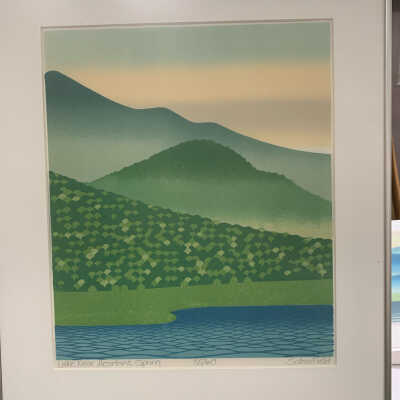

Print
Name/Title
Print
Description
Print on paper. Stacked-perspective landscape with blue-lined lake in the foreground with green beach. Two green hills in the middle-ground, the closest textured in three shades of green. Blue mountain in the background with light blue sky.
Acquisition
Accession
2021.42
Artwork Details
Medium
Paper, Ink
Made/Created
Artist Information
Field, Sabra Johnson (b. 1935)
Artist
Print Maker
Role
Date made
1982
Dimensions
Width
17 in
Height
19-1/4 in
Entry/Object ID
2021.42.2
Context
In 1982 Sabra Field was commissioned by IBM to produce four prints in celebration of 25 years at the Vermont plant. A limited run of 60 prints of each work was distributed to management and VIPs. A poster, including all four prints, IBMs logo with the word "Burlington" and a stylized 25 was produced in larger quantities for employees. The four prints depicted Vermont in four seasons. See objects 2021.42.1-5.
Sabra Field was born in Oklahoma, grew up in New York, and attended Middlebury College, graduating in 1957. Influenced by her art teachers Joseph Ablow and Arthur K. D. Healy, she resolved to become an artist. After further study at Wesleyan College, where she made her first woodcut prints, she taught art at various prep schools in Connecticut. Although married and the mother of two young sons, she was committed to pursuing her career as an artist. In 1965 she acquired a derelict 19th-century tavern “waiting to fall down” in the White River Valley, which she eventually restored and converted to a permanent home and studio.
Her work, much of it pastoral, became strongly associated with Vermont and the Vermont Landscape. She was commissioned to design the commemorative stamp for Vermont's bicentennial in 1991. The stamp sold over 60 million units and was one of the postal services best selling stamps of all time. She also designed imagery for calendars, credit cards, wine bottle labels, UNICEF cards, and hot air balloons. IBM, the Rockefeller Center at Dartmouth College, Billings Farm in Woodstock, Vermont Public Television, Vermont Life magazine, the Dartmouth-Hitchcock Medical Center, and Middlebury College.
-Adapted from Middlebury College press release
Sabra Field was born in Oklahoma, grew up in New York, and attended Middlebury College, graduating in 1957. Influenced by her art teachers Joseph Ablow and Arthur K. D. Healy, she resolved to become an artist. After further study at Wesleyan College, where she made her first woodcut prints, she taught art at various prep schools in Connecticut. Although married and the mother of two young sons, she was committed to pursuing her career as an artist. In 1965 she acquired a derelict 19th-century tavern “waiting to fall down” in the White River Valley, which she eventually restored and converted to a permanent home and studio.
Her work, much of it pastoral, became strongly associated with Vermont and the Vermont Landscape. She was commissioned to design the commemorative stamp for Vermont's bicentennial in 1991. The stamp sold over 60 million units and was one of the postal services best selling stamps of all time. She also designed imagery for calendars, credit cards, wine bottle labels, UNICEF cards, and hot air balloons. IBM, the Rockefeller Center at Dartmouth College, Billings Farm in Woodstock, Vermont Public Television, Vermont Life magazine, the Dartmouth-Hitchcock Medical Center, and Middlebury College.
-Adapted from Middlebury College press release
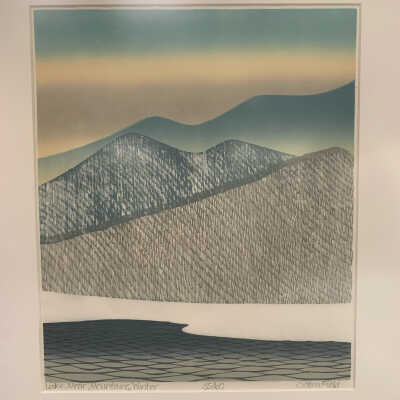

Print
Name/Title
Print
Description
Print on paper. Stacked-perspective landscape with dark-blue, lined lake in foreground with white beach. Textured grey and blue hills in the middle-ground with dark blue mountain in the background. Sky is grey, white, and blue.
Acquisition
Accession
2021.42
Artwork Details
Medium
Paper, Ink
Made/Created
Artist Information
Field, Sabra Johnson (b. 1935)
Artist
Print Maker
Role
Date made
1982
Dimensions
Width
17 in
Height
19-1/4 in
Entry/Object ID
2021.42.3
Context
In 1982 Sabra Field was commissioned by IBM to produce four prints in celebration of 25 years at the Vermont plant. A limited run of 60 prints of each work was distributed to management and VIPs. A poster, including all four prints, IBMs logo with the word "Burlington" and a stylized 25 was produced in larger quantities for employees. The four prints depicted Vermont in four seasons. See objects 2021.42.1-5.
Sabra Field was born in Oklahoma, grew up in New York, and attended Middlebury College, graduating in 1957. Influenced by her art teachers Joseph Ablow and Arthur K. D. Healy, she resolved to become an artist. After further study at Wesleyan College, where she made her first woodcut prints, she taught art at various prep schools in Connecticut. Although married and the mother of two young sons, she was committed to pursuing her career as an artist. In 1965 she acquired a derelict 19th-century tavern “waiting to fall down” in the White River Valley, which she eventually restored and converted to a permanent home and studio.
Her work, much of it pastoral, became strongly associated with Vermont and the Vermont Landscape. She was commissioned to design the commemorative stamp for Vermont's bicentennial in 1991. The stamp sold over 60 million units and was one of the postal services best selling stamps of all time. She also designed imagery for calendars, credit cards, wine bottle labels, UNICEF cards, and hot air balloons. IBM, the Rockefeller Center at Dartmouth College, Billings Farm in Woodstock, Vermont Public Television, Vermont Life magazine, the Dartmouth-Hitchcock Medical Center, and Middlebury College.
-Adapted from Middlebury College press release
Sabra Field was born in Oklahoma, grew up in New York, and attended Middlebury College, graduating in 1957. Influenced by her art teachers Joseph Ablow and Arthur K. D. Healy, she resolved to become an artist. After further study at Wesleyan College, where she made her first woodcut prints, she taught art at various prep schools in Connecticut. Although married and the mother of two young sons, she was committed to pursuing her career as an artist. In 1965 she acquired a derelict 19th-century tavern “waiting to fall down” in the White River Valley, which she eventually restored and converted to a permanent home and studio.
Her work, much of it pastoral, became strongly associated with Vermont and the Vermont Landscape. She was commissioned to design the commemorative stamp for Vermont's bicentennial in 1991. The stamp sold over 60 million units and was one of the postal services best selling stamps of all time. She also designed imagery for calendars, credit cards, wine bottle labels, UNICEF cards, and hot air balloons. IBM, the Rockefeller Center at Dartmouth College, Billings Farm in Woodstock, Vermont Public Television, Vermont Life magazine, the Dartmouth-Hitchcock Medical Center, and Middlebury College.
-Adapted from Middlebury College press release
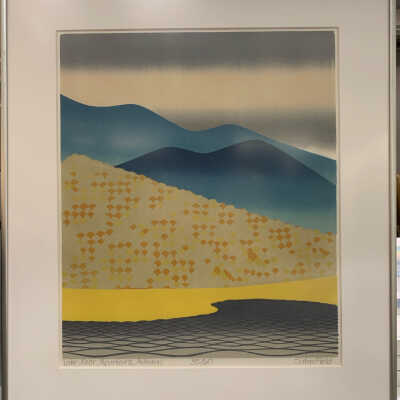

Print
Name/Title
Print
Description
Print on paper. Stacked perspective with blue-lined lake in foreground, yellow beach, beige hill with sylized trees in middle-ground, blue mountains in background with grey sky. Entitled "Lake Near Mountains, Autumn."
Acquisition
Accession
2021.42
Artwork Details
Medium
Paper, Ink
Made/Created
Artist Information
Field, Sabra Johnson (b. 1935)
Artist
Print Maker
Role
Date made
1982
Dimensions
Width
17 in
Height
19-1/4 in
Entry/Object ID
2021.42.4
Context
In 1982 Sabra Field was commissioned by IBM to produce four prints in celebration of 25 years at the Vermont plant. A limited run of 60 prints of each work was distributed to management and VIPs. A poster, including all four prints, IBMs logo with the word "Burlington" and a stylized 25 was produced in larger quantities for employees. The four prints depicted Vermont in four seasons. See objects 2021.42.1-5.
Sabra Field was born in Oklahoma, grew up in New York, and attended Middlebury College, graduating in 1957. Influenced by her art teachers Joseph Ablow and Arthur K. D. Healy, she resolved to become an artist. After further study at Wesleyan College, where she made her first woodcut prints, she taught art at various prep schools in Connecticut. Although married and the mother of two young sons, she was committed to pursuing her career as an artist. In 1965 she acquired a derelict 19th-century tavern “waiting to fall down” in the White River Valley, which she eventually restored and converted to a permanent home and studio.
Her work, much of it pastoral, became strongly associated with Vermont and the Vermont Landscape. She was commissioned to design the commemorative stamp for Vermont's bicentennial in 1991. The stamp sold over 60 million units and was one of the postal services best selling stamps of all time. She also designed imagery for calendars, credit cards, wine bottle labels, UNICEF cards, and hot air balloons. IBM, the Rockefeller Center at Dartmouth College, Billings Farm in Woodstock, Vermont Public Television, Vermont Life magazine, the Dartmouth-Hitchcock Medical Center, and Middlebury College.
-Adapted from Middlebury College press release
Sabra Field was born in Oklahoma, grew up in New York, and attended Middlebury College, graduating in 1957. Influenced by her art teachers Joseph Ablow and Arthur K. D. Healy, she resolved to become an artist. After further study at Wesleyan College, where she made her first woodcut prints, she taught art at various prep schools in Connecticut. Although married and the mother of two young sons, she was committed to pursuing her career as an artist. In 1965 she acquired a derelict 19th-century tavern “waiting to fall down” in the White River Valley, which she eventually restored and converted to a permanent home and studio.
Her work, much of it pastoral, became strongly associated with Vermont and the Vermont Landscape. She was commissioned to design the commemorative stamp for Vermont's bicentennial in 1991. The stamp sold over 60 million units and was one of the postal services best selling stamps of all time. She also designed imagery for calendars, credit cards, wine bottle labels, UNICEF cards, and hot air balloons. IBM, the Rockefeller Center at Dartmouth College, Billings Farm in Woodstock, Vermont Public Television, Vermont Life magazine, the Dartmouth-Hitchcock Medical Center, and Middlebury College.
-Adapted from Middlebury College press release
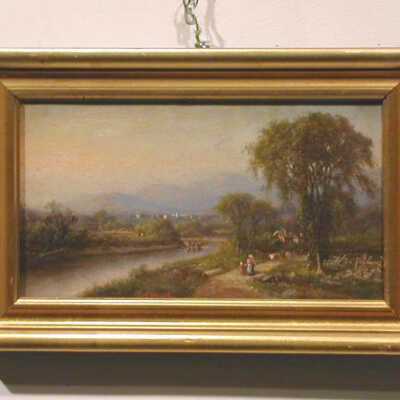

Strolling Beside Otter Creek
Interpretative Labels
Label
Martha Wood was born in England but moved to Schenectady, New York as a young girl. She studied art at Cooper Union in New York City and in Dresden and Munich, Germany. She came to Vermont to teach in Poultney. She built a house in Pittsford, VT, married and started a family there. She maintained a studio there even after moving for a time to New Jersey. She eventually moved back ti Vermont and shared a studio with her daughter, artist Hilda Belcher.
Name/Title
Strolling Beside Otter Creek
Type of Painting
Description
Oil on canvas showing a river running through a flat landscape with mountains along the horizon. There is a path to the right of the river on which two people and several animals are walking.
Acquisition
Accession
1993.23
Artwork Details
Medium
Oil
Made/Created
Artist Information
Belcher, Martha Jane Wood (1844-1930)
Artist
Date made
circa 1875
Dimensions
Width
4 in
Height
9 in
Depth
2 in
Entry/Object ID
1993.23.2
Context
Martha Wood was born in England but moved to Schenectady, New York as a young girl. She studied art at Cooper Union in New York City and in Dresden and Munich, Germany. She came to Vermont to teach in Poultney. She built a house in Pittsford, VT, married and started a family there. She maintained a studio there even after moving for a time to New Jersey. She eventually moved back to Vermont and shared a studio with her daughter, artist Hilda Belcher.
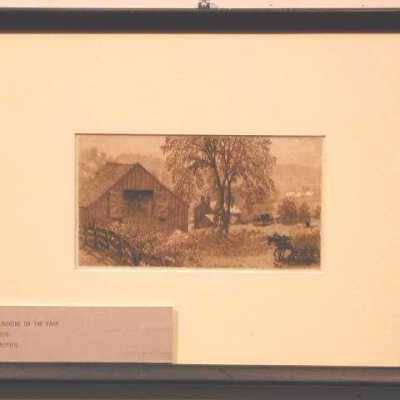

Sunshine on the Farm
Name/Title
Sunshine on the Farm
Description
Landscape. Fence lower left corner, barn, left, doors open, tree next to barn, center. A Farmer sitting in wagon filled with hay, pulled by two horses. Lower right corner house in background at bottom of hill. Buggy right center.
Acquisition
Source (if not Accessioned)
Unknown
Relationships
Related Publications
James Franklin Gilman
Publication
Artwork Details
Medium
Paper, Ink
Made/Created
Artist Information
Gilman, James Franklin (1850-1929)
Artist
Date made
1888
Dimensions
Width
7-3/4 in
Height
4-1/4 in
Entry/Object ID
VHS-A-257
Context
James Franklin Gilman was born in 1850 in Woburn, Massachusetts to John and Elizabeth Gilman. His father was a cordwainer and his mother a seamstress. Early census records indicate his mother was born in Vermont. Little is known of his early life or education.
By the late 1860s he evidently made his living as an itinerant artist, often depicting the farm landscape and/or portraits of those providing him with room and board. Works remain of farms and people in Chelmsford, Groton, and Billerica, MA.
In 1872 he arrived in Barre, Vermont, a tall man with red hair and a distinctive red beard. He spent over twenty years in the general vicinity of Barre, Montpelier, Plainfield, and Calais. Most of the time was spent boarding with various farm families, though he did open a studio and school in Montpelier for a time.
At some point in the late 1880s or early 1890s he joined the Church of Christian Scientists and became acquainted with church found Mary Baker Eddy. He ultimately sold all of his works and the contents of his studio, some say in reaction to a lost love, and moved back to Massachusetts. He famously illustrated a poem entitled "Christ and Christmas" by Eddy.
The last decade of his life was spent in Athol, MA were he lived on the edge of poverty.
By the late 1860s he evidently made his living as an itinerant artist, often depicting the farm landscape and/or portraits of those providing him with room and board. Works remain of farms and people in Chelmsford, Groton, and Billerica, MA.
In 1872 he arrived in Barre, Vermont, a tall man with red hair and a distinctive red beard. He spent over twenty years in the general vicinity of Barre, Montpelier, Plainfield, and Calais. Most of the time was spent boarding with various farm families, though he did open a studio and school in Montpelier for a time.
At some point in the late 1880s or early 1890s he joined the Church of Christian Scientists and became acquainted with church found Mary Baker Eddy. He ultimately sold all of his works and the contents of his studio, some say in reaction to a lost love, and moved back to Massachusetts. He famously illustrated a poem entitled "Christ and Christmas" by Eddy.
The last decade of his life was spent in Athol, MA were he lived on the edge of poverty.
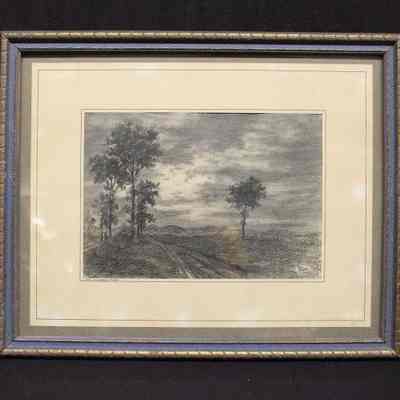

The Clouded Moon
Name/Title
The Clouded Moon
Description
Framed black and white drawing of a cloudy night sky overlooking a lone country road. In the center of the drawing is a cloudy sky, with a large patch of whiteness representing the moon. Below the sky are trees, three on the left of the drawing, one on the right. The ground is a very dark color, with a road cutting the dark ground in the middle. In the background of the drawing are mountains, spreading across the entire back of the drawing. On the bottom left of the drawing is the title of the piece, "The Clouded Moon." On the right side of the drawing, on the drawing itself is the artists signature. The picture is matted in a blue and gold frame. On the back of the frame the matt board is exposed, taped to the frame. Written on the back are the words, "Dusk/Charcoal SK." There is also a white card taped to the back of the matt, it reads, "Al Comi/ca 1927-37/charcoal on paper/Gift of the Estate of Ines Ruvera Comi,/2000
Acquisition
Accession
2014.60
Relationships
Related Person or Organization
Comi, Alfred Joseph Peter (1900-1986)
Person or Organization
Artwork Details
Medium
Charcoal, Paper
Made/Created
Artist Information
Comi, Alfred Joseph Peter (1900-1986)
Artist
Date made
1927-1937
Dimensions
Width
15-5/16 in
Length
12-1/4 in
Entry/Object ID
2014.60.1364
Type of Drawing
Context
Alfred Joseph Peter Comi was, born in Barre, Vermont. He graduated from Montpelier High School in 1919, and went to work for Jones Brothers Granite Company in Boston, Massachusetts. While in Boston he furthered his artistic studies by taking life drawing courses at the Copley Studios. He returned to Vermont in the early 1920's and was employed by the Vermont Marble Company in Proctor as a designer. In 1925 he became the chief designer for the Marr and Gordon Granite Company of Barre.
In 1927 he opened the Barre Design Studio, which he operated for several decades. That same year he married Ines Rivera of Barre and they resided in Montpelier until 1935 when they moved permanently to Barre.
He was very highly regarded and sought after in the granite industry. In fact, Anderson-Friberg's owner, Melvin Friberg noted "the unanimous respect of the manufacturers and dealers for Comi's designs, saying he is tops among professional designers and an elder statesman in the industry". He further stated "that outstanding orders were still received requesting his expertise and artistry...." long after Mr. Comi had retired.
Al Comi learned to paint with oils at the age of 54, studying under Stan Marc Wright, of Stowe, Vermont in 1954. By 1957 he and other local artists started an art exhibit at the Park on Main St. which attracted several thousand people.
He was the founding member of the Barre Paletteers, served as its president for eleven years and exhibited in every Paletters Art show from 1957 until his death. He was also a member of the Southern Vermont Artists Association, Vermont Art Association, the Chaffee Art Museum of Rutland, and Northern Vermont Artists.
In 1927 he opened the Barre Design Studio, which he operated for several decades. That same year he married Ines Rivera of Barre and they resided in Montpelier until 1935 when they moved permanently to Barre.
He was very highly regarded and sought after in the granite industry. In fact, Anderson-Friberg's owner, Melvin Friberg noted "the unanimous respect of the manufacturers and dealers for Comi's designs, saying he is tops among professional designers and an elder statesman in the industry". He further stated "that outstanding orders were still received requesting his expertise and artistry...." long after Mr. Comi had retired.
Al Comi learned to paint with oils at the age of 54, studying under Stan Marc Wright, of Stowe, Vermont in 1954. By 1957 he and other local artists started an art exhibit at the Park on Main St. which attracted several thousand people.
He was the founding member of the Barre Paletteers, served as its president for eleven years and exhibited in every Paletters Art show from 1957 until his death. He was also a member of the Southern Vermont Artists Association, Vermont Art Association, the Chaffee Art Museum of Rutland, and Northern Vermont Artists.
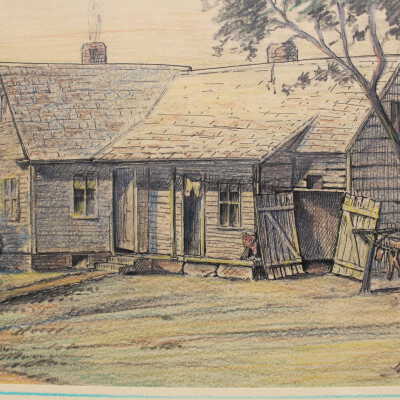

The Old Homestead
Name/Title
The Old Homestead
Description
Framed color picture of an old farm house. The farmhouse is built in a T-shape, with the lower half of the house facing the viewer. The lower half has two doors, and a porch with a pair of shorts hanging on the cloths. To the right of the porch are two open wooden doors leading into what appears to be a shed. Next to the open doors is another clothesline with long underwear hanging. The top half of the building is paneled with wood, and has a tiled roof with a brick chimney, smoke is coming out of the chimney. There is a dirt path leading to the door of the house. On both sides of the path there is a green lawn. The right side lawn has a large tree in the foreground of the drawing. The left side lawn has a bush that is right against the house. Some branches of a tree are sticking out of the left side of the frame. On the left side of the frame is the title, "The Old Homestead." On the right bottom corner, written on the picture is the artists signature, and the date, "1929." The back of the frame is covered in cardboard, which is taped to the frame. Written on the cardboard is, "House in East Barre VT/By Al Comi/Barre VT." There is also a white card tapped to the cardboard which reads, "Al Comi/The Old Homestead/1929/colored pencil on cameo paper/Gift of the Estate of Ines Ruvera Comi/2000."
Acquisition
Accession
2014.60
Relationships
Related Person or Organization
Comi, Alfred Joseph Peter (1900-1986)
Person or Organization
Artwork Details
Medium
Paper
Made/Created
Artist Information
Comi, Alfred Joseph Peter (1900-1986)
Artist
Date made
1929
Dimensions
Width
16-3/4 in
Length
12-3/4 in
Entry/Object ID
2014.60.1366
Type of Drawing
Context
Alfred Joseph Peter Comi was, born in Barre, Vermont. He graduated from Montpelier High School in 1919, and went to work for Jones Brothers Granite Company in Boston, Massachusetts. While in Boston he furthered his artistic studies by taking life drawing courses at the Copley Studios. He returned to Vermont in the early 1920's and was employed by the Vermont Marble Company in Proctor as a designer. In 1925 he became the chief designer for the Marr and Gordon Granite Company of Barre.
In 1927 he opened the Barre Design Studio, which he operated for several decades. That same year he married Ines Rivera of Barre and they resided in Montpelier until 1935 when they moved permanently to Barre.
He was very highly regarded and sought after in the granite industry. In fact, Anderson-Friberg's owner, Melvin Friberg noted "the unanimous respect of the manufacturers and dealers for Comi's designs, saying he is tops among professional designers and an elder statesman in the industry". He further stated "that outstanding orders were still received requesting his expertise and artistry...." long after Mr. Comi had retired.
Al Comi learned to paint with oils at the age of 54, studying under Stan Marc Wright, of Stowe, Vermont in 1954. By 1957 he and other local artists started an art exhibit at the Park on Main St. which attracted several thousand people.
He was the founding member of the Barre Paletteers, served as its president for eleven years and exhibited in every Paletters Art show from 1957 until his death. He was also a member of the Southern Vermont Artists Association, Vermont Art Association, the Chaffee Art Museum of Rutland, and Northern Vermont Artists.
In 1927 he opened the Barre Design Studio, which he operated for several decades. That same year he married Ines Rivera of Barre and they resided in Montpelier until 1935 when they moved permanently to Barre.
He was very highly regarded and sought after in the granite industry. In fact, Anderson-Friberg's owner, Melvin Friberg noted "the unanimous respect of the manufacturers and dealers for Comi's designs, saying he is tops among professional designers and an elder statesman in the industry". He further stated "that outstanding orders were still received requesting his expertise and artistry...." long after Mr. Comi had retired.
Al Comi learned to paint with oils at the age of 54, studying under Stan Marc Wright, of Stowe, Vermont in 1954. By 1957 he and other local artists started an art exhibit at the Park on Main St. which attracted several thousand people.
He was the founding member of the Barre Paletteers, served as its president for eleven years and exhibited in every Paletters Art show from 1957 until his death. He was also a member of the Southern Vermont Artists Association, Vermont Art Association, the Chaffee Art Museum of Rutland, and Northern Vermont Artists.
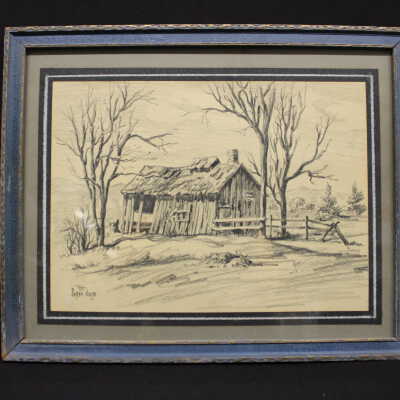

The Sugar House
Name/Title
The Sugar House
Description
Charcoal drawing of a sugar house. There are two trees on the right side of the house and one on the left next to a bush. They are all bare. A fence and road continue towards the right, and there are evergreen trees and mountains in the distance.
The frame is wood painted blue with gold patterns on the edge. The drawing is surrounded by black paper with a white line in the center. "The Sugar House" is written in the lower left of the drawing, and the signature is on the right side below the road.
On the back, "Now/Site 7. Redfield Hoare's Residence/Barre--E.MPR. Road" is written in pencil on the brown paper. In pen: "Charcoal Sketch/AL. Comi/3 Adams St./Barre VT". On a label, "Al Comi/The Sugar House/ca. 1927-37/charcoal on paper/Gift of the Estate of Ines Ruvera Comi, 2000" is typed.
The frame is wood painted blue with gold patterns on the edge. The drawing is surrounded by black paper with a white line in the center. "The Sugar House" is written in the lower left of the drawing, and the signature is on the right side below the road.
On the back, "Now/Site 7. Redfield Hoare's Residence/Barre--E.MPR. Road" is written in pencil on the brown paper. In pen: "Charcoal Sketch/AL. Comi/3 Adams St./Barre VT". On a label, "Al Comi/The Sugar House/ca. 1927-37/charcoal on paper/Gift of the Estate of Ines Ruvera Comi, 2000" is typed.
Acquisition
Accession
2014.60
Relationships
Related Person or Organization
Comi, Alfred Joseph Peter (1900-1986)
Person or Organization
Artwork Details
Medium
Charcoal
Made/Created
Artist Information
Comi, Alfred Joseph Peter (1900-1986)
Artist
Date made
1927-1937
Dimensions
Width
12-1/4 in
Height
15 in
Entry/Object ID
2014.60.1365
Context
Alfred Joseph Peter Comi was, born in Barre, Vermont. He graduated from Montpelier High School in 1919, and went to work for Jones Brothers Granite Company in Boston, Massachusetts. While in Boston he furthered his artistic studies by taking life drawing courses at the Copley Studios. He returned to Vermont in the early 1920's and was employed by the Vermont Marble Company in Proctor as a designer. In 1925 he became the chief designer for the Marr and Gordon Granite Company of Barre.
In 1927 he opened the Barre Design Studio, which he operated for several decades. That same year he married Ines Rivera of Barre and they resided in Montpelier until 1935 when they moved permanently to Barre.
He was very highly regarded and sought after in the granite industry. In fact, Anderson-Friberg's owner, Melvin Friberg noted "the unanimous respect of the manufacturers and dealers for Comi's designs, saying he is tops among professional designers and an elder statesman in the industry". He further stated "that outstanding orders were still received requesting his expertise and artistry...." long after Mr. Comi had retired.
Al Comi learned to paint with oils at the age of 54, studying under Stan Marc Wright, of Stowe, Vermont in 1954. By 1957 he and other local artists started an art exhibit at the Park on Main St. which attracted several thousand people.
He was the founding member of the Barre Paletteers, served as its president for eleven years and exhibited in every Paletters Art show from 1957 until his death. He was also a member of the Southern Vermont Artists Association, Vermont Art Association, the Chaffee Art Museum of Rutland, and Northern Vermont Artists.
In 1927 he opened the Barre Design Studio, which he operated for several decades. That same year he married Ines Rivera of Barre and they resided in Montpelier until 1935 when they moved permanently to Barre.
He was very highly regarded and sought after in the granite industry. In fact, Anderson-Friberg's owner, Melvin Friberg noted "the unanimous respect of the manufacturers and dealers for Comi's designs, saying he is tops among professional designers and an elder statesman in the industry". He further stated "that outstanding orders were still received requesting his expertise and artistry...." long after Mr. Comi had retired.
Al Comi learned to paint with oils at the age of 54, studying under Stan Marc Wright, of Stowe, Vermont in 1954. By 1957 he and other local artists started an art exhibit at the Park on Main St. which attracted several thousand people.
He was the founding member of the Barre Paletteers, served as its president for eleven years and exhibited in every Paletters Art show from 1957 until his death. He was also a member of the Southern Vermont Artists Association, Vermont Art Association, the Chaffee Art Museum of Rutland, and Northern Vermont Artists.
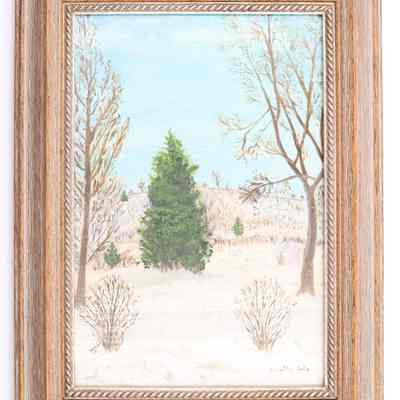

Untitled Landscape
Name/Title
Untitled Landscape
Type of Painting
Description
Small oil painting depicting a snowy landscape. The composition is framed on either side with trees, each with remnants of brown leaves attached to their branches. There is an equally sparse bush at the bottom of each tree, forming a U-shaped frame around the composition. At the center is a conical evergreen tree. The horizon is formed by a low hill, and the sky is a nearly uniform shade of blue. The lower right corner is signed, "Violetta Santo." The work is framed in a wood frame.
Acquisition
Accession
2023.14
Ethnography
Culture/Tribe
Relationships
Related Person or Organization
Santo, Pasquale "Patsy" (1893-1975)
Person or Organization
Artwork Details
Medium
Oil
Made/Created
Artist Information
Santo, Violetta Christine (1918-2011)
Artist
Dimensions
Width
9-3/8 in
Height
12-1/2 in
Entry/Object ID
2023.14.3
Context
Made by Violetta Santo of Bennington and later Rutland, Vermont and owned by her father, artist Patsy Santo. The painting came to the Vermont Historical Society with a group of personal items belonging to Patsy Santo.
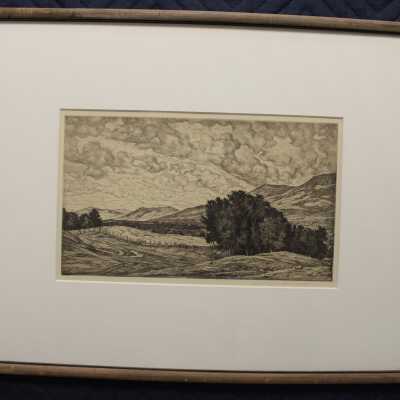

Vermont Splendor
Name/Title
Vermont Splendor
Description
Ink on paper print from etching by Luigi Lucioni entitled "American Splendor" and signed by the artist. Image depicts a plowed field in the foreground with a copse of trees to the right. A village with church steeple can be seen in the far middle-ground at the base of mountains rising left to right. About 1/2 of the image is sky with stylized clouds.
Acquisition
Accession
2014.60
Artwork Details
Medium
Paper, Ink
Made/Created
Artist Information
Lucioni, Luigi (1900-1988)
Artist
Date made
1942
Dimensions
Width
18-3/4 in
Height
14-5/8 in
Entry/Object ID
2014.60.1321
Context
Luigi Lucioni was born in Italy in 1900 but was raised in New York. He studied etching and engraving at Cooper Union and painting at the National Academy of Design. He split his time between New York and Vermont. At one point, Life Magazine called Vermont's "Painter Laureate."
A member of Southern Vermont Artists in Manchester, his paintings and prints of Vermont were regularly exhibited during their yearly shows. His traditional Vermont landscapes contrasted with his modern portrait paintings of such contemporary artists as Ethel Waters and Paul Cadmus.
Lucioni had connections to the Italian community of Barre and a number of his works ended up at the Aldrich Library and ultimately at the Vermont History Center. The contents of his Manchester studio were donated to Vermont Historical Society by later owners.
A member of Southern Vermont Artists in Manchester, his paintings and prints of Vermont were regularly exhibited during their yearly shows. His traditional Vermont landscapes contrasted with his modern portrait paintings of such contemporary artists as Ethel Waters and Paul Cadmus.
Lucioni had connections to the Italian community of Barre and a number of his works ended up at the Aldrich Library and ultimately at the Vermont History Center. The contents of his Manchester studio were donated to Vermont Historical Society by later owners.
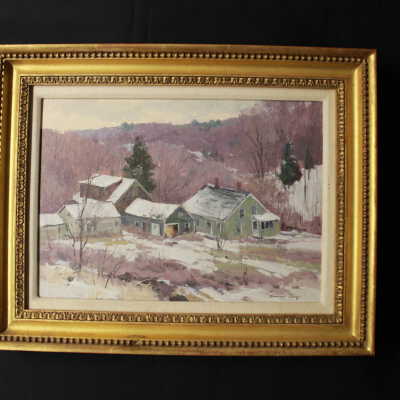

Vermont Winter
Name/Title
Vermont Winter
Description
Oil on canvas painting of a Vermont hill village on a gray winter day. Central to the painting is a cluster of three dwellings surrounded by hills, trees, brush and snow. Signed by artist Bernard Corey in lower left corner. Gallery label on back of work from Atlantic Gallery gives the title as "Vermont Winter."
Acquisition
Accession
2017.19
Artwork Details
Medium
Oil
Made/Created
Artist Information
Corey, Bernard (1914-2000)
Artist
Date made
1970-1980
Dimensions
Width
18-1/2 in
Height
14-1/2 in
Depth
1-1/2 in
Entry/Object ID
2017.19.1
Context
Bernard Corey (1914-2000) is a 20th-century American Impressionist painter. While Corey is identified with the historic Gloucester-Rockport Art Colony, he worked in many locations throughout New England and was associated with the Salmagundi Club in New York City, the Hudson Valley Art Association, the Providence Water Color Club, the Guild of Boston Artists, Allied Artists of America, as well as the Rockport Art Association.
A self-trained artist, Corey worked as a house painter as a young man, his landscape painting remaining a hobby. Then, in the early 1960s, he decided to dedicate himself to art and lived for some time in Rockport, honing his skills in the company of other artists. Throughout his life, Corey was admired by other artists for his dedication to painting on location, for long hours, in all kinds of weather. He went so far as to attach an easel to the dashboard of his car so that he could paint in rain, sleet or snow.
A self-trained artist, Corey worked as a house painter as a young man, his landscape painting remaining a hobby. Then, in the early 1960s, he decided to dedicate himself to art and lived for some time in Rockport, honing his skills in the company of other artists. Throughout his life, Corey was admired by other artists for his dedication to painting on location, for long hours, in all kinds of weather. He went so far as to attach an easel to the dashboard of his car so that he could paint in rain, sleet or snow.